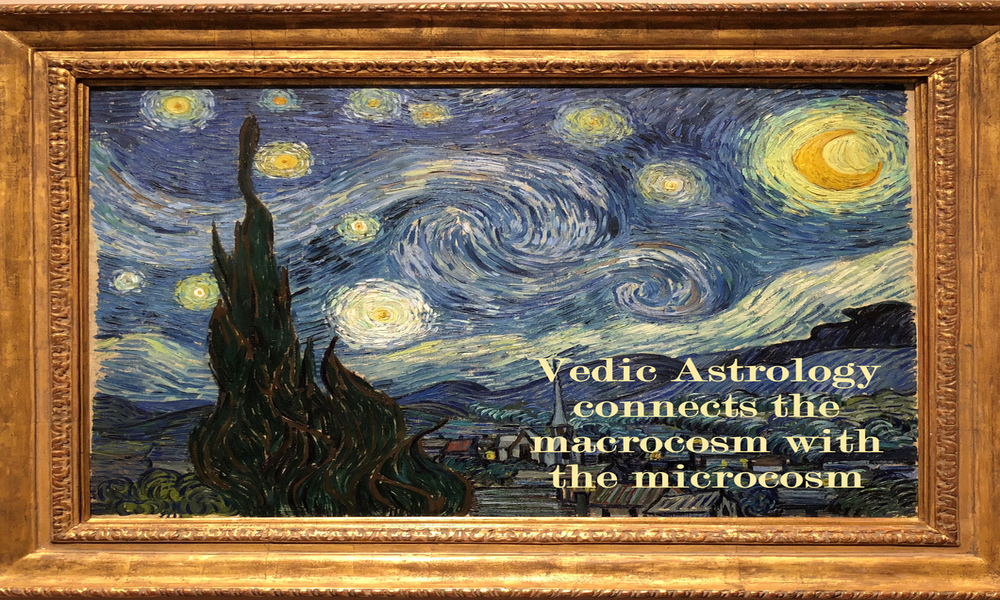
When we look up at the sky, we see an infinite number of stars, planets, galaxies and many more entities unknown to us. As living beings, we possess a strong relationship with our closest neighbor, the Moon. As is commonly known, the moon affects the Earth’s tides daily. Further, the word ‘lunacy,’ derived from the Latin lunaticus, refers to a mentally disturbed mind, conveying the long-held belief that the moon can induce insanity in a person. Just as the moon affects our planet, other planets in our solar system affect us as well but in different ways. Even though we cannot physically feel the effects of Saturn, Venus, Mars, Jupiter or Mercury, their energies have strong implications on our destinies. This is the basic premise of Vedic Astrology—that all things in our universe are connected and influence each other.
Many consider Vedic Astrology as a pseudoscience that is not really worthy of attention. But at the same time, astrological concepts are pervasive in many major decisions among Hindus all across the globe, including timing marriage with auspicious dates, naming a newborn by a certain vowel or letter, buying a home during a good time period and celebrating major Hindu holidays based on the lunar calendar. Indeed, it is a useful spiritual science to many, but it is not fully explained or widely understood. For instance, the Sanskrit term for Vedic Astrology is Jyotish. ‘Jyot’ means light and ‘Ish’ means God. In the 7th century AD, a sage named Parara wrote a 71 chapter instruction manual called “Bhat Parara Hor? Sastra.” It is one of the original texts that many Vedic Astrologers use to interpret birth charts.
So how does Vedic Astrology work, and how does it compare with Western Astrology? According to ancient seers, Vedic Astrology reveals the map of your life and the results of your “karmas” from past lives through the positions of planets at the exact moment of your birth. Paramahansa Yogananda, a spiritual guru from India, and the author of the book “Autobiography of a Yogi” penned: “A child is born on the day and at the hour when the celestial rays are in mathematical harmony with his/her individual karma.”
The difference between Western Astrology and Vedic Astrology lies in two distinct areas: remedial methods and the Dasha system, which are aspects that are unique to Jyotish. Vedic Astrology incorporates spiritual solutions to issues in all areas of life through remedies such as chanting mantras, wearing specific gemstones, donating and fasting/cleansing on certain days. Secondly, Vedic Astrology incorporates a timing system called the “Dasha system.” This unique timing system is based on your individual birth chart, and this Dasha system can predict specific events in your life, such as marriage, the birth of a child, a career trajectory, an education path, et cetera.
Now, the big question that I often come across in this practice is “when and how will love happen for me?” By combining the method of the Dasha system and analyzing the planets that signify marriage in one’s birth chart, one can narrow down the exact time period of marriage. For those who are wondering, I successfully predicted the timing of my own marriage! However, don’t sweat it if you are not there yet. In the meantime, you can enhance your personal energies that promote love and make it more likely for you.
Depending on the placement of planet Venus on the day of your birth, we can determine many characteristics of how you love and certain specifics of your relationship with your partner. Moreover, if you are having difficulties in this area of life, the Vedic astrology texts offer long-term remedial methods which are quite practical and logical!
First of all, let’s understand what Venus represents:
- Love
- Beauty
- Enjoyment
- Partner
- Sensual gratification
- Material gains
You can improve the Venus energies within yourself by basic remedies such as:
- Dancing
- Going to art galleries
- Painting
- Wearing Beautiful clean clothes (please, do not wear ripped clothing!)
- Matchmaking
- Wearing diamonds
These basic “Venus remedies” invoke beauty, love, enjoyment and sensual gratification that will not only improve your chances with love but will also make you a more attractive and loving person inside.
Remember, the need for love is hardwired and universal, but it is also twofold—the need to be loved, and the need to love others.




